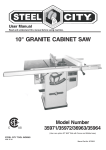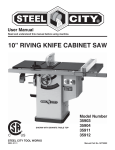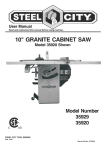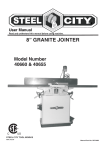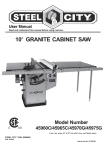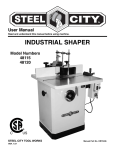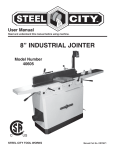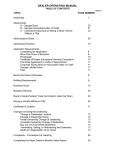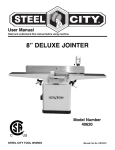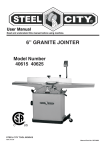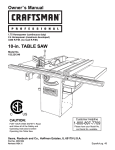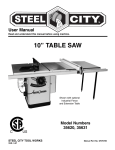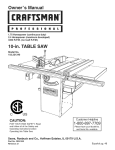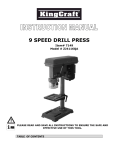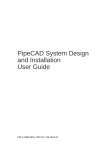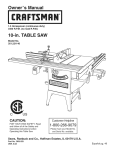Download TABLE SAW - Leeway Workshop, LLC
Transcript
User Manual Read and understand this manual before using machine. TABLE SAW Shown with optional Fence Model Numbers 35600 35605 ® C US STEEL CITY TOOL WORKS Manual Part No. OR70131 eel City Table St w ne ur yo ng si ha rc pu THANK YOU for tested, and inspected , ed gn si de en be s ha w Saw. This table sa ly used and er op pr n he W d. in m in , with you, the customer e you with years of id ov pr ill w w sa e bl ta maintained, your by one of the ed ck ba is it hy w is ch trouble free service, whi s in the business. ie nt ra ar w ry ne hi ac m t longes products in the Steel y an m of e on st ju is w This table sa ry and is proof of ne hi ac m ng ki or dw oo w City’s family of satisfaction. er om st cu l ta to to t en our commitm cellence each and ex r fo ve ri st to ue in nt co At Steel City we customer. For r ou u, yo of n io in op e every day and value th City Tool Works, l ee St or w sa e bl ta ur yo comments about works.com . ol to ty ci el te .s w w w at te please visit our web si 2 TABLE OF CONTENTS INTRODUCTION SECTION 1 Warranty .................................................................................................................................................4 SECTION 2 Product Specifications ............................................................................................................................7 SECTION 3 Accessories and Attachments ................................................................................................................7 SECTION 4 Definition of Terms ..................................................................................................................................8 SECTION 5 Feature Identification ..............................................................................................................................9 SECTION 6 General Safety......................................................................................................................................10 SECTION 7 Product Safety ......................................................................................................................................12 SECTION 8 Electrical Requirements........................................................................................................................13 SECTION 9 Unpacking & Inventory..........................................................................................................................15 SECTION 10 Assembly ..............................................................................................................................................17 SECTION 11 Adjustments ..........................................................................................................................................22 SECTION 12 Operations ............................................................................................................................................28 SECTION 13 Maintenance .........................................................................................................................................33 SECTION 14 Troubleshooting ....................................................................................................................................34 SECTION 15 Parts List..........................................................................................................................................36-41 INTRODUCTION This user manual is intended for use by anyone working with this machine. It should be kept available for immediate reference so that all operations can be performed with maximum efficiency and safety. Do not attempt to perform maintenance or operate this machine until you have read and understand the information contained in this manual. The drawings, illustrations, photographs, and specifications in this user manual represent your machine at time of print. However, changes may be made to your machine or this manual at any time with no obligation to Steel City Tool Works. 3 WARRANTY STEEL CITY TOOL WORKS 5 YEAR LIMITED WARRANTY Steel City Tool Works, LLC (“SCTW”) warrants all “STEEL CITY TOOL WORKS” machinery to be free of defects in workmanship and materials for a period of 5 years from the date of the original retail purchase by the original owner. SCTW will repair or replace, at its expense and at its option, any SCTW machine, machine part, or machine accessory which in normal use has proven to be defective, provided that the customer returns the product, shipping prepaid, to an authorized service center with proof of purchase and provides SCTW with a reasonable opportunity to verify the alleged defect by inspection. This warranty does not apply to defects due directly or indirectly to misuse, abuse, negligence, accidents, or lack of maintenance, or to repairs or alterations made or specifically authorized by anyone other than SCTW. Normal wear components are also excluded under this coverage. Every effort has been made to ensure that all SCTW machinery meets the highest quality and durability standards. We reserve the right to change specifications at any time due to our commitment to continuous improvement of the quality of our products. EXCEPT AS SET FORTH ABOVE, SCTW MAKES NO EXPRESS OR IMPLIED REPRESENTATIONS OR WARRANTIES WITH RESPECT TO ITS MACHINERY, OR ITS CONDITION, MERCHANTABILITY, OR FITNESS FOR ANY PARTICULAR PURPOSE OR USE. SCTW FURNISHES THE ABOVE WARRANTIES IN LIEU OF ALL OTHER WARRANTIES, EXPRESS OR IMPLIED, INCLUDING THE WARRANTIES OF MERCHANTABILITY AND FITNESS FOR A PARTICULAR PURPOSE, WHICH ARE HEREBY SPECIFICALLY DISCLAIMED. SCTW SHALL NOT BE LIABLE FOR ANY (A) SPECIAL, INDIRECT, INCIDENTAL, PUNITIVE OR CONSEQUENTIAL DAMAGES, INCLUDING WITHOUT LIMITATION LOSS OF PROFITS, ARISING FROM OR RELATED TO THIS WARRANTY, THE BREACH OF ANY AGREEMENT OR WARRANTY, OR THE OPERATION OR USE OF ITS MACHINERY, INCLUDING WITHOUT LIMITATION DAMAGES ARISING FROM DAMAGE TO FIXTURES, TOOLS, EQUIPMENT, PARTS OR MATERIALS, DIRECT OR INDIRECT LOSS CAUSED BY ANY OTHER PARTY, LOSS OF REVENUE OR PROFITS, FINANCING OR INTEREST CHARGES, AND CLAIMS BY ANY THIRD PERSON, WHETHER OR NOT NOTICE OF SUCH POSSIBLE DAMAGES HAS BEEN GIVEN TO SCTW; (B) DAMAGES OF ANY KIND FOR ANY DELAY BY OR FAILURE OF SCTW TO PERFORM ITS OBLIGATIONS UNDER THIS AGREEMENT; OR (C) CLAIMS MADE A SUBJECT OF A LEGAL PROCEEDING AGAINST SCTW MORE THAN ONE (1) YEAR AFTER SUCH CAUSE OF ACTION FIRST AROSE. The validity, construction and performance of this Warranty and any sale of machinery by SCTW shall be governed by the laws of the Commonwealth of Pennsylvania, without regard to conflicts of laws provisions of any jurisdiction. Any action related in any way to any alleged or actual offer, acceptance or sale by SCTW, or any claim related to the performance of any agreement including without limitation this Warranty, shall take place in the federal or state courts in Allegheny County, Pennsylvania. STEEL CITY TOOL WORKS 4 WARRANTY CARD Name ________________________________________________ Street _______________________________________________ Apt. No. ______________________________________________ City _________________________ State ______ Zip __________ Phone Number_________________________________________ E-Mail ________________________________________________ The following information is given on a voluntary basis and is strictly confidential. Where did you purchase your STEEL CITY machine? Store: ____________________________________________ City:______________________________________________ 2. How did you first learn of Steel City Tool Works? ___ Advertisement ___ Mail Order Catalog ___ Web Site ___ Friend ___ Local Store ! CUT HERE 3. 4. 5. 6. 7. do you subscribe to? ___ American How-To ___ Family Handyman ___ Fine Woodworking ___ Journal of Light Construction ___ Popular Mechanics ___ Popular Woodworking ___ Old House Journal ___ Popular Science ___ Today’s Homeowner ___ WOOD ___ WOODEN Boat ___ Woodsmith ___ Woodcraft ___ Woodshop News ___ Woodwork ___ Woodworker ___ Workbench ___ Woodworker’s Journal Other_________________ What is your age group? ___ 20 to 29 years ___ 40 to 49 years ___ 60 to 69 years How many Steel City machines do you own? _____________ 12. Which portable / hand held power tools do you own? Check all that apply. ___ Belt Sander ___ Biscuit Jointer ___ Dust Collector ___ Circular Saw ___ Detail Sander ___ Drill / Driver ___ Miter Saw ___ Palm Sander ___ Orbital Sander ___ Portable Thickness Planer ___ Saber Saw ___ Router ___ Reciprocating Saw Other_______________________ 13. What machines / accessories would you like to see added to the STEEL CITY line? ____________________________________________________ ____________________________________________________ Which of the following woodworking / remodeling shows do you watch? ___ Backyard America ___ The American Woodworker ___ Home Time ___ The New Yankee Workshop ___ This Old House ___ Woodwright’s Shop Other__________________________________________ What is your annual household ___ $20,000 to $29,999 ___ $40,000 to $49,999 ___ $60,000 to $69,999 ___ $80,000 to $89,999 9. 11. Which benchtop tools do you own? Check all that apply. ___ Belt Sander ___ Belt / Disc Sander ___ Drill Press ___ Band Saw ___ Grinder ___ Mini Jointer ___ Mini Lathe ___ Scroll Saw ___ Spindle / Belt Sander Other______________________ Other_______________________ Which of the following magazines ___ American Woodworker ––– Cabinetmaker ___ Fine Homebuilding How would you rank your woodworking skills? ___ Simple ___ Intermediate ___ Advance ___ Master Craftsman 10. What stationary woodworking tools do you own? Check all that apply. ___ Air Compressor ___ Band Saw ___ Drill Press ___ Drum Sander ___ Dust Collection ___ Horizontal Boring Machine ___ Jointer ___ Lathe ___ Mortiser ___ Panel Saw ___ Planer ___ Power Feeder ___ Radial Arm Saw ___ Shaper ___ Spindle Sander ___ Table Saw ___ Vacuum Veneer Press ___ Wide Belt Sander Other____________________________________________ Product Description:_____________________________________ Model No.: ___________________________________________ Serial No. _____________________________________________ 1. 8. 14. What new accessories would you like to see added? ____________________________________________________ ____________________________________________________ income? ___ $30,000 to $39,999 ___ $50,000 to $59,999 ___ 70,000 to $79,999 ___ $90,000 + 15. Do you think your purchase represents good value? ___ No ___Yes 16. Would you recommend STEEL CITY products to a friend? ___ No ___ Yes ___ 30 to 39 years ___ 50 to 59 years ___ 70 + years 17. Comments: ____________________________________________________ ____________________________________________________ ____________________________________________________ ____________________________________________________ ____________________________________________________ How long have you been a woodworker? ___ 0 to 2 years ___ 2 to 8 years ___ 8 to 20 years ___ over 20 years 5 FOLD ON DOTTED LINE PLACE STAMP HERE Steel City Tool Works P.O. Box 10529 Murfreesboro, TN 37129 FOLD ON DOTTED LINE 6 PRODUCT SPECIFICATIONS Model Number 35600 Model Number 35605 Motor type Induction Induction HP 1.75 3 Amps 15 / 7.5 13 Volts 115 / 230 230 Hertz 60 60 RPM 3450 3450 Blade Tilt Left Left Blade Drive Poly-V Belt Poly-V Belt Blade Diameter 10-in 10-in Blade Arbor 5/8-in 5/8-in Number of Teeth 40 40 Blade Speed 3450 3450 Max Depth of cut at 90° 3-3/8-in 3-3/8-in Max Depth of cut at 45° 2-1/4-in 2-1/4-in Table in front of blade at max depth of cut 12-1/2-in 12-1/2-in Max Dado width 13/16-in 13/16-in Max Dado blade diameter 8-in 8-in Left and right table wing 12-in cast iron 12-in cast iron Footprint 20” x 22” 20” X 22” Length 44” 44” Width 32” 32” Height 40” 40” Net Weight 320lbs 334lbs Length 30-1/2-in 30-1/2-in Width 29-1/2-in 29-1/2-in Height 43-in 43-in Gross Weight 370 lbs 385 lbs Product Dimensions Shipping Dimensions ACCESSORIES AND ATTACHMENTS There are a variety of accessories available for your Steel City Product. For more information on any accessories associated with this and other machines, please contact your nearest Steel City distributor, or visit our website at: www.steelcitytoolworks.com. 7 DEFINITION OF TERMS Anti-Kickback Fingers – A safety device attached to the blade guard and splitter assembly designed to minimize the chance of a workpiece being thrown back during a cutting operation. Heeling – The misalignment of the blade to the miter slots; when the blade is not parallel to the miter slots. Kerf – The material removed by the blade in the workpiece during any cutting operation. Arbor – The shaft on which the blade or accessory cutting-tool is mounted. Kickback – When the workpiece is thrown back toward the operator at a high rate of speed during a cutting operation. Bevel Cut – The operation of making any cut with the blade set on a degree other than 90 degrees. Miter Cut – The operation of making a cut using the miter gauge at any angle other than zero degrees. Compound Cut – The operation of making both a bevel and a miter cut at one time. Push Stick – An accessory device that can be made or purchased to help push the workpiece through the blade. A push stick is used to keep the operator’s hands away from the blade when ripping a narrow workpiece. Crosscut – The operation of making a cut across the grain or width of a workpiece. Dado – A non-through cut that produces a square notch. A dado is typically from 1/8-in. to 13/16-in. wide. A dado requires a special set of blades, not included with this table saw. Rabbet – A square notch in the edge of the workpiece. Rip Cut – The operation of making a cut with the grain of the workpiece. Featherboard – An accessory device that can be made or purchased to help guide or hold down a workpiece during cutting operations. Saw Blade Path – The area that is directly in line with the blade, including area over, under, behind and in front of it. Freehand – A very dangerous operation of making a cut without using the fence or miter gauge in a cutting operation. FREEHAND CUTS MUST NEVER BE PERFORMED ON A TABLE SAW. Set of the Saw Blade – The distance that the tips of the saw blade are angled outwards from the thickness of the blade. The set of the saw blade teeth allows for the blade body to pass safely through all cuts. Gum, Pitch or Resin – A sticky, sap based residue that comes from wood products. Table/Work Area – The total surface of the top of the table saw on which the workpiece rests while set-up or cutting operations are being performed. 8 FEATURE IDENTIFICATION A B F E H C G D A) Miter Gauge B) Blade Guard Assembly C) Motor Cover D) Bevel Scale E) Raise/Lower Handwheel F) Bevel Adjustment Handwheel G) Fence Hooks H) On/Off Switch (shown with an optional fence) 9 GENERAL SAFETY ! ! WARNING WARNING TO AVOID serious injury and damage to the machine, read and follow all Safety and Operating Instructions before assembling and operating this machine. This manual is not totally comprehensive. It does not and can not convey every possible safety and operational problem which may arise while using this machine. The manual will cover many of the basic and specific safety procedures needed in an industrial environment. Exposure to the dust created by power sanding, sawing, grinding, drilling and other construction activities may cause serious and permanent respiratory or other injury, including silicosis (a serious lung disease), cancer, and death. Avoid breathing the dust, and avoid prolonged contact with dust. The dust may contain chemicals known to the State of California to cause cancer, birth defects or other reproductive harm. All federal and state laws and any regulations having jurisdiction covering the safety requirements for use of this machine take precedence over the statements in this manual. Users of this machine must adhere to all such regulations. Some examples of these chemicals are: • Lead from lead-based paints. • Crystalline silica from bricks, cement and other masonry products. • Arsenic and chromium from chemically-treated lumber. Below is a list of symbols that are used to attract your attention to possible dangerous conditions. ! This is the safety alert symbol. It is used to alert you to potential personal injury hazards. Obey all safety messages that follow this symbol to avoid possible injury or death. ! Always operate tool in well ventilated area and provide for proper dust removal. Use a dust collection system along with an air filtration system whenever possible. Always use properly fitting NIOSH/OSHA approved respiratory protection appropriate for the dust exposure, and wash exposed areas with soap and water. DANGER Indicates an imminently hazardous situation which, if not avoided, WILL result in death or serious injury. ! 1. To avoid serious injury and damage to the machine, read the entire User Manual before assembly and operation of this machine. WARNING Indicates a potentially hazardous situation which, if not avoided, COULD result in death or serious injury. ! CAUTION ! WARNING Indicates a potentially hazardous situation, if not avoided, MAY result in minor or moderate injury. It may also be used to alert against unsafe practices. CAUTION 2. ALWAYS wear eye protection. Any machine can throw debris into the eyes during operations, which could cause severe and permanent eye damage. Everyday eyeglasses are NOT safety glasses. ALWAYS wear Safety Goggles (that comply with ANSI standard Z87.1) when operating power tools. CAUTION used without the safety alert symbol indicates a potentially hazardous situation which, if not avoided, may result in property damage. NOTICE This symbol is used to alert the user to useful information about proper operation of the machine. 10 ! 11. DO NOT FORCE the machine to perform an operation for which it was not designed. It will do a safer and higher quality job by only performing operations for which the machine was intended. WARNING 12. DO NOT stand on a machine. Serious injury could result if it tips over or you accidentally contact any moving part. 3. ALWAYS wear hearing protection. Plain cotton is not an acceptable protective device. Hearing equipment should comply with ANSI S3.19 Standards. ! 13. DO NOT store anything above or near the machine. 14. DO NOT operate any machine or tool if under the influence of drugs, alcohol, or medication. WARNING 15. EACH AND EVERY time, check for damaged parts prior to using any machine. Carefully check all guards to see that they operate properly, are not damaged, and perform their intended functions. Check for alignment, binding or breakage of all moving parts. Any guard or other part that is damaged should be immediately repaired or replaced. 4. ALWAYS wear a NIOSH/OSHA approved dust mask to prevent inhaling dangerous dust or airborne particles. 16. Ground all machines. If any machine is supplied with a 3-prong plug, it must be plugged into a 3contact electrical receptacle. The third prong is used to ground the tool and provide protection against accidental electric shock. DO NOT remove the third prong. 5. ALWAYS keep the work area clean, well lit, and organized. DO NOT work in an area that has slippery floor surfaces from debris, grease, and wax. 6. ALWAYS unplug the machine from the electrical receptacle when making adjustments, changing parts or performing any maintenance. 17. Keep visitors and children away from any machine. DO NOT permit people to be in the immediate work area, especially when the machine is operating. 7. AVOID ACCIDENTAL STARTING. Make sure that the power switch is in the “OFF” position before plugging in the power cord to the electrical receptacle. ! 18. KEEP protective guards in place and in working order. 19. MAINTAIN your balance. DO NOT extend yourself over the tool. Wear oil resistant rubber soled shoes. Keep floor clear of debris, grease, and wax. WARNING 20. MAINTAIN all machines with care. ALWAYS KEEP machine clean and in good working order. KEEP all blades and tool bits sharp. 8. AVOID a dangerous working environment. DO NOT use electrical tools in a damp environment or expose them to rain or moisture. ! 21. NEVER leave a machine running, unattended. Turn the power switch to the OFF position. DO NOT leave the machine until it has come to a complete stop. 22. REMOVE ALL MAINTENANCE TOOLS from the immediate area prior to turning the machine ON. WARNING 23. SECURE all work. When it is possible, use clamps or jigs to secure the workpiece. This is safer than attempting to hold the workpiece with your hands. 9. CHILDPROOF THE WORKSHOP AREA by removing switch keys, unplugging tools from the electrical receptacles, and using padlocks. 24. STAY ALERT, watch what you are doing, and use common sense when operating any machine. DO NOT operate any machine tool while tired or under the influence of drugs, alcohol, or medication. A moment of inattention while operating power tools may result in serious personal injury. 10. DO NOT use electrical tools in the presence of flammable liquids or gasses. 11 25. USE ONLY recommended accessories. Use of incorrect or improper accessories could cause serious injury to the operator and cause damage to the machine. If in doubt, DO NOT use it. 3. Prevent electrical shock. Follow all electrical and safety codes, including the National Electrical Code (NEC) and the Occupational Safety and Health Regulations (OSHA). All electrical connections and wiring should be made by qualified personnel only. 26. THE USE of extension cords is not recommended for 230V equipment. It is better to arrange the placement of your equipment and the installed wiring to eliminate the need for an extension cord. If an extension cord is necessary, refer to the chart in the Grounding Instructions section to determine the minimum gauge for the extension cord. The extension cord must also contain a ground wire and plug pin. ! WARNING 4. TO REDUCE the risk of electrical shock. DO NOT use this machine outdoors. DO NOT expose to rain or moisture. Store indoors in a dry area. 27. Wear proper clothing, DO NOT wear loose clothing, gloves, neckties, or jewelry. These items can get caught in the machine during operations and pull the operator into the moving parts. Users must wear a protective cover on their hair, if the hair is long, to prevent it from contacting any moving parts. 5. STOP using this machine, if at any time you experience difficulties in performing any operation. Contact your supervisor, instructor or machine service center immediately. 28. SAVE these instructions and refer to them frequently and use them to instruct other users. 6. Safety decals are on this machine to warn and direct you to how to protect yourself or visitors from personal injury. These decals MUST be maintained so that they are legible. REPLACE decals that are not legible. 29. Information regarding the safe and proper operation of this tool is also available from the following sources: Power Tool Institute 1300 Summer Avenue Cleveland, OH 44115-2851 www.powertoolinstitute.org 7. DO NOT leave the unit plugged into the electrical outlet. Unplug the unit from the outlet when not in use and before servicing, performing maintenance tasks, or cleaning. National Safety Council 1121 Spring Lake Drive Itasca, IL 60143-3201 8. ALWAYS turn the power switch “OFF” before unplugging the table saw. American National Standards Institute 25 West 43rd Street, 4th floor New York, NY 10036 www.ansi.org ! ANSI 01.1 Safety Requirements for Woodworking Machines, and the U.S. Department of Labor regulations www.osha.gov WARNING 9. DO NOT handle the plug or table saw with wet hands. 10. USE accessories only recommended by Steel City. PRODUCT SAFETY 11. DO NOT pull the table saw by the power cord. NEVER allow the power cord to come in contact with sharp edges, hot surfaces, oil or grease. 1. Serious personal injury may occur if normal safety precautions are overlooked or ignored. Accidents are frequently caused by lack of familiarity or failure to pay attention. Obtain advice from supervisor, instructor, or another qualified individual who is familiar with this machine and its operations. 12. DO NOT unplug the table saw by pulling on the power cord. ALWAYS grasp the plug, not the cord. 13. REPLACE a damaged cord immediately. DO NOT use a damaged cord or plug. If the table saw is not operating properly, or has been damaged, left outdoors or has been in contact with water. 2. Every work area is different. Always consider safety first, as it applies to your work area. Use this machine with respect and caution. Failure to do so could result in serious personal injury and damage to the machine. 14. DO NOT use the table saw as a toy. DO NOT use near or around children. 12 15. ENSURE that the machine sits firmly on the floor before using. If the machine wobbles or is unstable, correct the problem by using shims or blocks prior to operation. 22. DO NOT use the rip fence as a guide when crosscutting. 23. BE MINDFUL of flaws in the wood. Cutting a warped or twisted board along the rip fence can get pinched between the fence and the blade, causing a kickback. 16. KEEP saw blade sharp and clean. Failure to do so greatly increases friction, decreases cut quality, and increases the possibility of a kickback. 24. ALWAYS remove cut off pieces and scraps from the table before starting the saw. 17. MAKE CERTAIN the saw blade is parallel with the miter slots and with the rip fence. A blade that is not aligned parallel can cause the workpiece to be pinched between the blade and the fence causing burning or kickbacks. 25. NEVER start the machine with the workpiece against the blade. 26. NEVER perform freehand operations. Use either the fence or miter gauge to position and guide the workpiece through the blade. 18. ALWAYS use blade guard on all through cuts. This will help prevent the cut from closing on the back of the saw blade. The blade guard also has anti-kickback fingers which minimize the chance of a workiece being thrown back during a cutting operation. 27. ALWAYS use a pushstick for ripping narrow workpieces. 28. NEVER have any part of your body in line with the path of the saw blade. If a kickback occurs with you directly in front of the blade, a serious injury can occur. 19. ALWAYS push the workpiece past the blade. DO NOT release a workpiece until it is past the blade and removed from the saw. 29. NEVER attempt to free a stalled blade without first turning the machine off and disconnecting the saw from the power source. 20. DO NOT execute a cut when you do not have complete control of the situation. 21. DO NOT cut a workpiece that is too large for you to handle. ELECTRICAL REQUIREMENTS ! prewired for 115 volt operation. If you decide to convert the saw to 230V, you will have to replace the 115 volt plug on the switch with a UL/CSA Listed plug, suitable for 230 volts. The table saw with a 230 volt plug should only be connected to an outlet having the same configuration as the plug. No adapter is available or should be used with the 230 volt plug. Once the modification has been made to the plug of the switch, be sure to follow the instructions under CHANGING MOTOR VOLTAGE for changing the motor voltage from 115 volt to 230 volt in the ADJUSTMENTS section of this manual. WARNING To reduce the risk of electric shock, follow all electrical and safety codes, including the National Electric Code (NEC) and the Occupational Safety and Health Regulations (OSHA). All electrical connections and wiring should be made by qualified personnel only. This manual is written for two specific models, Model No 35600 and Model No 35605. Please follow the specific requirements for your model saw. MODEL NO 35605 The switch provided with your saw is a magnetic switch designed for 230 volt single phase usage only. The switch has a plug that is designed to plug into a 230 volt outlet. There are many different configurations for 230 volt outlets, so it is conceivable that the configuration of the plug may not match the configuration of your existing outlet. If this is the case, you will have to replace the plug with a UL/CSA approved plug that matches the configuration of your 230V outlet. MODEL NO 35600 The switch provided with your saw is a dual voltage capable switch, meaning it is designed to function at either 115 or 230 volts. The switch and saw comes 13 GROUNDING INSTRUCTIONS ! EXTENSION CORDS WARNING ! WARNING This machine MUST BE GROUNDED while in use to protect the operator from electric shock. To reduce the risk of fire or electrical shock, use the proper gauge of extension cord. When using an extension cord, be sure to use one heavy enough to carry the current your machine will draw. In the event of a malfunction or breakdown, GROUNDING provides the path of least resistance for electric current and reduces the risk of electric shock. The plug MUST be plugged into a matching electrical receptacle that is properly installed and grounded in accordance with ALL local codes and ordinances. The smaller the gauge-number, the larger the diameter of the extension cord is. If in doubt of the proper size of an extension cord, use a shorter and thicker cord. An undersized cord will cause a drop in line voltage resulting in a loss of power and overheating. If a plug is provided with your machine DO NOT modify the plug. If it will not fit your electrical receptacle, have a qualified electrician install the proper connections to meet all electrical codes local and state. All connections must also adhere to all of OSHA mandates. ! IMPROPER ELECTRICAL CONNECTION of the equipment-grounding conductor can result in risk of electric shock. The conductor with the green insulation (with or without yellow stripes) is the equipment-grounding conductor. DO NOT connect the equipment-grounding conductor to a live terminal if repair or replacement of the electric cord or plug is necessary. CAUTION USE ONLY a 3-wire extension cord that has a 3-prong grounding plug and a 3-pole receptacle that accepts the machine’s plug. If you are using an extension cord outdoors, be sure it is marked with the suffix “W-A” (“W” in Canada) to indicate that it is acceptable for outdoor use. Check with a qualified electrician or service personnel if you do not completely understand the grounding instructions, or if you are not sure the tool is properly grounded. Make certain the extension cord is properly sized, and in good electrical condition. Always replace a worn or damaged extension cord immediately or have it repaired by a qualified person before using it. PLUGS/RECEPTACLES Protect your extension cords from sharp objects, excessive heat, and damp or wet areas. ! WARNING MINIMUM RECOMMENDED GAUGE FOR EXTENSION CORDS (AWG) 115 VOLT OPERATION ONLY • Electrocution or fire could result if this machine is not grounded properly or if the electrical configuration does not comply with local and state electrical codes. 0 to 6 Amps 6 to 10 Amps 10 to 12 Amps 12 to 15 Amps • MAKE CERTAIN the machine is disconnected from power source before starting any electrical work. 50’ LONG 100’ LONG 18 AWG 18 AWG 16 AWG 14 AWG 16 AWG 16 AWG 16 AWG 12 AWG 16 AWG 14 AWG 14 AWG Not recommended MINIMUM RECOMMENDED GAUGE FOR EXTENSION CORDS (AWG) • MAKE SURE the circuit breaker does not exceed the rating of the plug and receptacle. 230 VOLT OPERATION ONLY The motor supplied with your machine is either a 115/230 dual voltage motor (Model 35600) or a dedicated 230 volt, single phase motor (Model 35605). Never connect the green or ground wire to a live terminal. The machine should only be connected to an outlet having the same configuration as the plug. 25’ LONG 0 to 6 Amps 6 to 10 Amps 10 to 12 Amps 12 to 15 Amps 14 25’ LONG 50’ LONG 100’ LONG 18 AWG 18 AWG 16 AWG 14 AWG 18 AWG 18 AWG 16 AWG 12 AWG 16 AWG 14 AWG 14 AWG Not recommended UNPACKING & INVENTORY ! can be removed by spraying WD-40 on them and wiping it off with a soft cloth. This may need redone several times before all of the protective coatings are removed completely. WARNING After cleaning, apply a good quality paste wax to any unpainted surfaces. Make sure to buff out the wax before assembly. • The machine is heavy, two people are required to unpack and lift. Compare the items to inventory figures; verify that all items are accounted for before discarding the shipping box. • Use a safety strap to avoid tip over when lifting machine. Check shipping carton and machine for damage before unpackaging. Carefully remove packaging materials, parts and machine from shipping carton. Always check for and remove protective shipping materials around motors and moving parts. Lay out all parts on a clean work surface. ! WARNING If any parts are missing, do not attempt to plug in the power cord and turn “ON” the machine. The machine should only be turned “ON” after all the parts have been obtained and installed correctly. For missing parts, contact Steel City at 1-877-SC4-TOOL. Remove any protective materials and coatings from all of the parts and the table saw. The protective coatings I A B H G C F D E A) Dust Port E) Handwheel Lock Knob (2) I) B) Blade Guard and Splitter Assembly F) Handwheel Assembly (2) C) On/Off Switch G) Splitter Mounting Rod J) Fence Hooks (2) (not shown) D) Miter Gauge H) Splitter Bracket Assembly 15 Blade Wrenches K) Wrench Hook (not shown) L) M8 x 1.25 x 30mm Hex Head Screw (8) L M) M8 Flat Washer (8) N) M8 Lockwasher (8) O) 1/4-20 x 1/2” Round Head Screw (10) M N O P P) Cast Iron Wings 16 ASSEMBLY ! POLY-V BELT ASSEMBLY WARNING WARNING • The table saw is a heavy machine; two people may be required for certain assembly operations. ! • DO NOT assemble the table saw until you are sure the tool is unplugged. MAKE CERTAIN THAT THE SAW IS DISCONNECTED FROM THE POWER SOURCE. • DO NOT assemble the table saw until you are sure the power switch is in the “OFF” position. Fig. 2 • For your own safety, DO NOT connect the machine to the power source until the machine is completely assembled and you read and understand this entire User Manual. B INSTALLATION AND LEVELING A Final location for the saw must be level, dry, well lighted, and have enough room to allow movement around the saw with long pieces of wood stock. Level the saw front to back and side to side, using a carpenter’s level placed on the table. Use shims under the corners, if necessary, but make sure the saw is stable before being placed into service. C DUST PORT ASSEMBLY ! WARNING 1. Make sure all packaging material has been removed from inside the cabinet. MAKE CERTAIN THAT THE SAW IS DISCONNECTED FROM THE POWER SOURCE. 2. Open the motor cover and place the motor Poly-V belt (A) over the blade pulley (B). SEE FIG. 2. Fig. 1 3. Carefully lift the motor (C) and place the belt under the motor pulley (not shown). Make sure all the v-notches in the belt are mated with the v-notches of the blade pulley and motor pulley. A 4. Carefully let the motor down and close motor cover. EXTENSION WING ASSEMBLY ! WARNING MAKE CERTAIN THAT THE SAW IS DISCONNECTED FROM THE POWER SOURCE. 1. CAUTION: The extension wings are heavy; two people are required to assemble both extension wings to the table saw. 1. Attach the dust port (A) to the opening in the bottom rear of the cabinet with four 1/4-20 x 1/2” round head tap screws. SEE FIG. 1. 17 HANDWHEEL ASSEMBLY Fig. 3 ! A WARNING MAKE CERTAIN THAT THE SAW IS DISCONNECTED FROM THE POWER SOURCE. Fig. 5 D B B B C 2. Assemble one of the extension wings (A) to the left side of the table saw. Align the four holes (B) in the extension wing with the four holes in the left side of the saw table. Use four M8 x 30mm hex head screws, M8 lock washers and M8 flat washers to attach the wing to the table. Do not completely tighten hardware at this time. SEE FIG. 3. A 1. Place one of the handwheels (A) onto the blade raise/lower shaft (B) located on the front of the cabinet. Align the groove (C) in the back of the handwheel with the pin (D). SEE FIG. 5. Fig. 4 D E Fig. 6 E C 3. Lay a straight edge or level (C) across the saw table (D) and extension wing (E). Make sure that the front face of the extension wing is flat to the front face of the saw table. Adjust the extension wing so that its top surface is exactly flat to the saw table and securely tighten hardware. SEE FIG. 4. 2. Thread the locking knob (E) onto the threaded end of the shaft. SEE FIG. 6. 4. Repeat steps 2 and 3 above to assemble the other extension wing to the right side of the table saw. 3. Repeat the steps above to assemble the remaining handwheel and locking knob onto the bevel shaft located on the side of the cabinet. 18 WRENCH AND FENCE HOOK ASSEMBLY ! 2. Place the threaded end of the mounting splitter rod (A) through the hole (B) in the rear of the cabinet. Place a M12 hex nut (not shown) onto the threaded end of the mounting splitter rod inside of the cabinet and tighten securely. SEE FIGS. 8 AND 9. WARNING Note: Place an 18mm wrench on 12mm hex nut and a 13mm wrench on flats of the splitter rod and tighten. MAKE CERTAIN THAT THE SAW IS DISCONNECTED FROM THE POWER SOURCE. Fig. 9 Fig. 7 C C A B A 1. Assemble both of the fence hooks (A) to the left side of the cabinet (B) using four 1/4-20 c 1/2” round head screws, not shown. SEE FIG. 7. 2. Assemble the wrench hook (C) above the fence hooks using two sheet metal screws, not shown. 3. Place the splitter bracket assembly (C) onto the mounting splitter rod. SEE FIG. 9. BLADE GUARD AND SPLITTER ASSEMBLY ! Fig. 10 WARNING MAKE CERTAIN THAT THE SAW IS DISCONNECTED FROM THE POWER SOURCE. F D 1. Remove the table insert. Note: Remove the table insert retaining bolt used to secure the table insert to the saw table. E Fig. 8 G 4. Place the front attachment point (D) of the blade guard and splitter assembly down into the tool-less front attachment point (E). Place the rear attachment slot (F) onto the threads of the splitter bracket knob (G); securely tighten splitter bracket knob. Note: The splitter bracket assembly will need to be positioned to fit the blade guard and splitter assembly on the mounting splitter rod. SEE FIG. 10. B 19 Fig. 11 7. Place a square (N) onto the saw table and against the splitter assembly (O) behind the kickback fingers (P). Make adjustments to the splitter bracket assembly (Q) so that the splitter is square to the saw table. Once square, tighten the two hex socket head screws on the bottom of the splitter bracket assembly. SEE FIG. 12. Z Fig. 13 L M I K J 5. Remove the hex nut (K) and outer flange (J) from the blade arbor (I). Note: The arbor has a right hand thread; to loosen the hex nut turn it counterclockwise. T 6. Place 10” saw blade (Z) onto blade arbor (I), make sure the teeth of the blade are pointing down in the front of the table saw. Place the outer flange (J) and hex nut (K) onto the blade arbor and snug hex nut by hand. Place the open-end blade wrench (L) on the flats of the inner blade flange (not shown) and the box-end blade wrench (M) onto the hex nut and securely tighten. Note: The blade arbor has a right hand thread, to tighten the hex nut turn it clockwise. SEE FIG. 11. S R Fig. 12 8. Lay a straight edge (R) against the left side of the saw blade (S). Align the splitter (T) so that it is in a straight line with the blade and tighten the one hex socket head screw on top of the splitter bracket assembly. SEE FIG. 13. Q O 9. Replace table insert and tighten table insert retaining bolt removed in step 1. 10. If there is any problem with the front splitter attachment bracket being out-of-square to the saw table or blade alignment, see “ALIGNING SPLITTER BRACKET” in the Adjustments section of this manual. N 20 CONNECTING SWITCH CORD TO MOTOR CORD ! Fig. 13B C WARNING MAKE CERTAIN THAT THE SAW IS DISCONNECTED FROM THE POWER SOURCE. 1. Place the switch cord (A) through hole (B) in front of cabinet. SEE FIG. 13A. D Fig. 13A 2. Open motor cover, insert three prong switch cord (C) into three hole outlet (D) of the motor cord. SEE FIG. 13B. B 3. Pull slack in switch cord into the cabinet. A MOUNTING RAILS, FENCE AND TABLE BOARD The rails, fence assembly, and table board can now be mounted to the saw. See Owner’s Manual for Fence Assembly Instructions which will address the mounting of these parts. 21 ADJUSTMENTS RAISING AND LOWERING THE BLADE To tilt the blade bevel to 45-degrees, loosen the handwheel lock knob (counterclockwise) and turn the handwheel clockwise. When the saw blade is at 45-degrees it will come into contact with the adjustable positive stop which will cause the blade to stop. Tighten the handwheel lock knob (clockwise) until it is securely tightened. Fig. 16 B ADJUSTING BLADE BEVEL POSITIVE STOPS Fig. 17 A B The blade height adjustment handwheel and handwheel lock knob are located on the front of the cabinet above the blade bevel scale. To raise the saw blade, loosen the handwheel lock knob (A) (counterclockwise) and turn the handwheel (B) clockwise. When the saw blade is at its desired height, tighten the handwheel lock knob (clockwise) until it is securely tightened. SEE FIG. 16. A 1. To adjust blade to a 90-degree blade bevel positive stop, raise the saw blade (A) to its highest position. SEE FIG. 17. To lower the saw blade, loosen the handwheel lock knob (counterclockwise) and turn the handwheel counterclockwise. When the saw blade is at its desired height, tighten the handwheel lock knob (clockwise) until it is securely tightened. 2. Using a combination square (B) check that the blade is 90 degrees to the saw table (zero degrees on bevel scale). 3. If the blade will not tilt to 90 degrees, turn (counterclockwise) the set screw in the left miter slot of the saw table until the blade can be positioned to 90 degrees. TILTING THE BLADE The blade bevel handwheel and handwheel lock knob are located on the left side of the cabinet. To increase the saw blade bevel, loosen the handwheel lock knob (counterclockwise) and turn the handwheel clockwise. When the saw blade is at its desired degree, tighten the handwheel lock knob (clockwise) until it is securely tightened. 4. Once the blade has been tilted to 90 degrees (confirm this using your square), tighten the bevel handwheel lock knob, located on the side of the cabinet. This will keep the blade from tilting further. 5. Turn the set screw (clockwise) until it comes in contact with the positive stop. To return the saw blade bevel to zero degrees, loosen the handwheel lock knob (counterclockwise) and turn the handwheel counterclockwise. When the saw blade is back to zero degrees it will come into contact with the adjustable positive stop which will cause the blade to stop. Tighten the handwheel lock knob (clockwise) until it is securely tightened. 6. Loosen the bevel handwheel lock knob located on the side of the cabinet, and rotate bevel handwheel until the blade is at 45 degrees to the saw table. 22 7. If the blade will not tilt to 45 degrees, turn (counterclockwise) the set screw located just to the right of the right miter slot, until the blade can be positioned to 45 degrees. CHECKING BLADE ALIGNMENT Fig. 18 Blade heel is the misalignment of the blade to the miter slots. This means when the blade is not parallel to the miter slots, it is heeling. The blade is set parallel at the factory and should not need any adjustments. You can check this by using a dial indicator (not included) or a combination square (not included). It is recommended to check the alignment before initial operation as follows: C ! WARNING MAKE CERTAIN THAT THE SAW IS DISCONNECTED FROM THE POWER SOURCE. Fig. 20 8. Using a combination square (C), make sure that the blade is at 45 degrees. SEE FIG. 18. 9. With the blade at 45 degrees, tighten the bevel handwheel lock knob to keep the blade from further tilting. D 10. Turn the set screw clockwise until it comes in contact with the positive stop. C BEVEL ARROW ADJUSTMENT 1. Make certain that the blade is at 90-degrees to the table surface with a combination square. B A Fig. 19 A 1. Raise the saw blade to its highest point. 2. Place a combination square (A) on the saw table with one edge (B) of the square against the left miter slot (C). SEE FIG. 20. 3. Adjust the square so the rule (D) just touches the saw blade. Make sure the rule is not touching any of the carbide tips of the saw blade. 4. Lock the rule in this position. 2. Check that the bevel arrow is pointing to the zero degree mark on the bevel scale located on the front of the cabinet. SEE FIG. 19. 3. To adjust arrow, loosen the Philips head screw (A), and reposition the bevel arrow and tighten screw. 23 Fig. 21 Fig. 22 E A B 1. To align the blade parallel to the miter slot, first loosen two hex head screws (A) under the left side of the table saw. This is the same side as the bevel handwheel (B). SEE FIG. 22. 6. Rotate the saw blade back so that you take the measurement from the same spot on the saw blade. SEE FIG. 21. Fig. 23 7. Take a reading at the rear of the blade (E) with the combination square. If there is a difference of more than .010 between the rule and the blade, then an adjustment will have to be made. 8. If an adjustment is necessary, see “ADJUSTING BLADE ALIGNMENT.” C C ADJUSTING BLADE ALIGNMENT ! WARNING Blade alignment is factory set and should not need adjustment. All saw blades have some runout. Therefore, readjusting the blade alignment should only be attempted if it becomes necessary (see checking blade alignment). ! 2. Open motor cover located on the right side of the table saw. Loosen two hex head screws (C) located directly above the opening. SEE FIG. 23. 3. The saw table is now loose and can be repositioned until the blade is parallel to the miter slot. Repeat steps in “CHECKING BLADE ALIGNMENT.” WARNING MAKE CERTAIN THAT THE SAW IS DISCONNECTED FROM THE POWER SOURCE. 4. When blade is parallel to miter slot, tighten all four hex head screws. 5. Recheck blade alignment. 6. Tilt the blade to 45 degrees, and rotate the saw blade by hand. Make sure the blade does not contact the table insert. 24 TABLE INSERT ADJUSTMENT CHANGING MOTOR VOLTAGE This section only applies to Model 35600 with the 1-3/4HP Motor. The 35605 Model with the 3HP motor will only run at 230V. WARNING ! MAKE CERTAIN THAT THE SAW IS DISCONNECTED FROM THE POWER SOURCE. ! Fig. 24 WARNING MAKE CERTAIN THAT THE SAW IS DISCONNECTED FROM THE POWER SOURCE. Have a certified electrician make all electrical connections. All local and state codes must be maintained. D D The motor supplied with the table saw is a dual voltage 115/230-volt, single phase motor. The motor is wired from the factory for 115-volt operation. To change to 230-volt operation for your table saw, proceed with the following instructions. It is also necessary to replace the 115 volt plug, supplied with the table saw, with a UL/CSA Listed plug (not included) suitable for 230 volts and the rated current of the motor. The table saw with a 230 volt plug should only be connected to an outlet having the same configuration as the plug. No adapter is available or should be used with the 230 volt plug. A Fig. 25 B E A C B D 1. Make sure the switch is “OFF” and disconnect power cord from power source. 1. The table insert (A) must always be level with the saw table (B). To adjust the table insert, loosen and remove table insert retaining bolt (C). SEE FIG. 24. 2. Open motor cover and verify on the motor tag that motor is dual voltage. 3. If motor tag states that it is dual voltage remove junction box cover (A) on motor (B). SEE FIG. 25. 2. Place a straight edge across the front and rear of the table insert. Check that the insert is perfectly level with the saw table. 4. Using wiring diagram on inside of junction box cover, reconnect motor leads for 230-volt operation. 3. To level the table insert, turn the one or more adjusting set screws (D) as needed and recheck. 5. Replace junction box cover and close motor cover. 6. Replace the 115-volt plug with a plug rated for 230volt operation. 4. Once the insert is level, secure the insert with the retaining bolt removed in step 1. 5. The table insert is equipped with a finger hole (E) for easy removal. 7. The ON/OFF switch is 4-pole and does not need modified. 25 CHANGING THE SAW BLADE ! ALIGNING SPLITTER BRACKET WARNING ! • Turn the power switch “OFF” and unplug the power cord from its power source when changing the saw blade. WARNING MAKE CERTAIN THAT THE SAW IS DISCONNECTED FROM THE POWER SOURCE. • USE ONLY 10-in diameter blades with 5/8-inch arbor holes, rated at or higher than 3800 R.P.M. Fig. 27 Fig. 26 A B A B E C D 1. To adjust front splitter bracket (A), loosen the two hex socket head cap screws (B). SEE FIG. 27. 1. Remove blade guard and splitter. Fig. 28 2. Remove the table insert retaining bolt and remove the table insert. E 3. Unlock the raise/lower handwheel lock and raise saw blade to maximum height. D 4. Two wrenches are supplied with the table saw. Place one open-end wrench (A) on the flat of the saw arbor to keep it from turning. Place the closedend wrench (B) on the arbor nut (C). Turn the arbor nut wrench toward the front of saw to loosen it. Remove arbor nut, blade flange (D) and saw blade (E). SEE FIG. 26. 5. Assemble the new saw blade; make certain the teeth point down at the front of the saw table and assemble the blade flange and arbor nut. Using both blade wrenches as previously mentioned, tighten arbor nut in the opposite direction from which it was loosened. C 2. Place a straight edge (C) along the side of blade (D) and adjust the front splitter bracket to align the splitter (E) with the blade. SEE FIG. 28. 6. Replace table insert and tighten the table insert retaining bolt. 3. Once splitter bracket is aligned, retighten hex socket head cap screw from STEP 1. 7. Replace blade guard and splitter 26 MITER GAUGE ADJUSTMENT ! ADJUSTING POSITIVE STOPS Fig. 30 WARNING MAKE CERTAIN THAT THE SAW IS DISCONNECTED FROM THE POWER SOURCE. E D Fig. 29 B A C 1. To adjust 0-degree positive stops, loosen knob (B), pull out on plunger (C) and turn miter gauge over. 2. Loosen the lock nut (D) 3 or 4 turns. SEE FIG. 30. 3. Place a square against the guide bar and front of the miter gauge body. Square the miter gauge body to the guide bar and tighten knob. 1. The miter gauge has adjustable positive stops at 0-degree and plus or minus 45-degrees or it can be manually set at any angle between plus or minus 60-degrees. 4. Push in plunger and make adjustments to stop screw (E) so that it touches the plunger and tighten lock nut. 2. To rotate miter gauge body (A), loosen knob (B) and pull out plunger (C) and rotate miter gauge body to desired angle and tighten knob. SEE FIG. 29. 5. Recheck the positive stop angle to the saw blade. Insert the guide bar into the miter slot and slide the miter gauge up to the saw blade. 3. To rotate to the next positive stop, pull plunger (C) out, rotate miter gauge body then push plunger back in and continue rotating miter gauge body until it stops against next positive stop. 6. To check, place a square against the saw blade and miter gauge body. If any more adjustments are need repeat steps above. 7. To set both 45-degree positive stops, repeat steps 1 thru 6 above. 27 OPERATIONS ! 1. The ON/OFF switch is located under the front rail on the table saw. CAUTION • A separate electrical circuit should be used for your table saw. The circuit should not be less than #14 AWG wire and should be protected with a 15-amp time lag fuse. 2. To turn the table saw on, press the green “START” button (A) in one-half inch. Note: There is a safety feature on the switch to insure that the switch must be completely pressed before the saw will START. SEE FIG. A. • Have a qualified electrician repair or replace damaged or worn cord immediately. 3. To turn the table saw off, press the large red “OFF” paddle (B) or lift the paddle and press directly on the red “OFF” button. • Before connecting the motor to the power line, make certain the switch is in the “OFF” position and be sure that the electric current is of the same characteristics as the motor nameplate. All line connections should make good contact. 4. When the table saw is not in use, the “ON” button should be locked so that it cannot be started. 5. Using a padlock (not provided), it is possible to lock the switch to prevent unauthorized use. Lift the red “OFF” paddle and place a padlock through the holes (C) in the side of the “ON” button and then lock the padlock. Make sure keys have been removed from padlock and placed where no children can get them. SEE FIG. A. • Running on low voltage or long extension cords will damage the motor. ! WARNING • DO NOT expose the table saw to rain or operate the in damp locations. 6. To use the table saw, unlock and remove the padlock from the “ON” button. • MAKE SURE all parts have been assembled correctly and are in working order. • KEEP table surface clear of tools and debris before starting table saw. THERMAL-OVERLOAD PROTECTION STARTING AND STOPPING THE SAW ! WARNING • Turn the power switch “OFF” and unplug the power cord from its power source prior to doing or performing any maintenance. Fig. A • Make certain that the “OFF” button has been depressed before pushing the thermal-overload reset button. C The motor supplied with your table saw has a resettable thermal-overload relay located on the side of the switch. If the motor shuts off during an operation (cutting a workpiece too fast or using a dull blade, using the saw beyond its capacity, or low voltage) press the “OFF” button and let the motor cool three to five minutes. Push the reset thermal-overload button on the side of the ON/OFF switch assembly. Make certain that the saw blade and work area has been cleared of debris before restarting saw. The motor can now be turned on again. A B 28 ! PRE-RUN CHECK WARNING Before you begin to use your Table Saw, you should give it a thorough inspection, making sure you ask yourself the following questions: MAKE CERTAIN THAT THE SAW IS DISCONNECTED FROM THE POWER SOURCE. 1. Is the blade mounted correctly? ! 2. Is the saw stable? WARNING 3. Is it wired properly? 4. Is your electrical system properly configured? 5. Haved you checked your workpiece for obvious defects? ALWAYS wear eye protection. Any machine can throw debris into the eyes during operations, which could cause severe and permanent eye damage. Everyday eyeglasses are NOT safety glasses. ALWAYS wear Safety Goggles (that comply with ANSI standard Z87.1) when operating power tools. 6. Is the guard assembly installed and functional? 7. Have you checked the saw blade clearance when it is adjusted to varying angles and depths? 8. Have you read all the warnings and directions regarding the operation of this machine? ! WARNING TEST RUN 1. Face the table saw and stand to the left of the blade path. ALWAYS wear a NIOSH/OSHA approved dust mask to prevent inhaling dangerous dust or airborne particles. 2. With one finger on the ON button and one finger on the OFF button, turn the saw on. Be ready to turn the saw off in case of a mishap. 3. Watch and listen to the saw. Note whether there are any unusual sounds or excessive vibrations. NOTICE 4. If anything appears abnormal, immediately turn off the saw, unplug it, and fix the problems. If a problem exists that is beyond the scope of this manual, contact your dealer. The following section was designed to give instructions on the basic operations of this table saw. However, it is in no way comprehensive of every table saw application. It is strongly recommended that you read books, trade magazines, or get formal training to maximize the potential of your table saw and to minimize the risks. 5. If the saw is behaving normally, turn it off and prepare to make a cut according to the instructions outlined in this section. 29 BLADE SELECTION 3. Combination Blade: Used for cutting with and across the grain. A compromise between a rip blade and a cross-cut blade, a 10” combination blade will typically have between 40-50 teeth. SEE FIG. 33. Choosing the correct blade for the job is essential for the safe and efficient use of your table saw. Ignoring this important step could result in damage to the saw and serious injury to the operator. Below are the most common saw blades and their uses. Fig. 33 1. Rip Blade: Used for cutting with the grain. Typically, 10” rip blades have between 18-40 teeth and large gullets to allow for large chip removal. SEE FIG. 31. Fig. 31 4. Thin-kerf: Most types of saw blades are available in a thin-kerf style. Designed primarily to minimize stock waste, thin-kerf blades are used in conjunction with a blade stabilizer to reduce blade wobble. Note: Many blade guards/splitters are thicker than many thin-kerf blades. Make sure that the stock will pass by the guard/splitter before beginning a cut. 2. Cross-cut Blade: Used for cutting across the grain. 10” cross-cut blades have between 60-80 teeth and a shallow gullet. SEE FIG. 32. Fig. 32 5. Dado Blades: There are two types of dado blades: stack and wobble. Stack dadoes involve more setup time, but they provide a superior finish cut when compared to a wobble dado. 6. Moulding Heads: A moulding head is a cutterhead that attaches to the arbor and holds individual moulding knives. They are very dangerous and require training beyond the scope of this manual. This section on blade selection is by no means comprehensive. Always follow the saw blade manufacturer’s recommendations to assure safe and efficient operation of your table saw. 30 CROSSCUTTING RIPPING Crosscutting means cutting across the grain of the wood. In wood products without grain (i.e. MDF, particleboard), crosscutting simply means cutting across the width of the stock. Ripping means to cut with the grain of the wood. In other materials such as MDF or plywood, ripping simply means to cut lengthwise. To rip a board: 1. Inspect the board for soundness. You will need a straightedge to rip with accuracy. Your workpiece may need to be jointed flat before attempting to cut on the table saw. Crosscuts are made with the miter gauge. There are two miter gauge slots in the table top. Use the one that works best for the piece being crosscut. To make a crosscut using the miter gauge: ! 1. Inspect the board for soundness. You do not necessarily need a square edge to crosscut with accuracy. WARNING Never attempt to rip a board that does not have one perfectly straight edge on it. Always run the straight edge of the board against the rip fence. Failure to do this could result in kickback and serious personal injury. 2. Inspect the miter gauge. Is it properly set and tight? Move the rip fence completely out of the way. 3. Turn on the saw and allow it to come to full speed. 4. Hold the workpiece firmly against the face of the miter gauge and ease it into the blade and through the workpiece. SEE FIG. 34. 2. Set the rip fence to the desired distance from the blade. IF YOU ARE MAKING NARROW CUTS, USE A PUSH-STICK. Serious injury can occur if you put your hands close to the blade. A push-stick pattern has been included at the end of this manual. Use it to hold the workpiece against the table and fence and push the workpiece fully past the blade. When a small width is to be ripped and a push-stick cannot be safely put between the blade and rip fence, rip a larger piece to obtain the desired piece. Fig. 34 3. Turn on the saw and allow it to reach full speed. Place the trued edge of the board against the rip fence. Feed the workpiece slowly and evenly into the blade and through the workpiece. When ripping, always stand off to the side of the workpiece and push it through, making sure to keep your fingers out of line with the blade. SEE FIG. 35. Fig. 35 5. Turn off the saw and allow the blade to come to a full stop. ! WARNING Small cutoff pieces can contact the moving blade and be thrown back toward the operator. Always use the least amount of clearance between the table insert and the blade to reduce the risk of injury from these pieces. Never attempt to grab these pieces while the table saw is turned on. Your hand may come into contact with the blade. Turn the table saw off and safely remove these pieces AFTER the blade has come to a complete stop. 31 Do not stand directly behind the workpiece when ripping. SEE FIG. 36. ! Fig. 36 WARNING Dado operations present very real hazards requiring proper procedures to avoid serious injury. The chance of kickback is always greater when dado blades are used so extra precautions must be used. Any movement of the stock away from the fence will cause kickback. Be certain that stock is flat and straight. Failure to follow these warnings could result in serious personal injury. ! CAUTION Always use push sticks, featherboards, push paddles and other safety accessories whenever possible to increase safety and control during operations which require the blade guard and splitter to be removed from the saw. ALWAYS replace the blade guard after dadoing is complete. Proper dado operations will differ depending on the blade system you choose. Consult the instructions included with your dado blades for directions regarding attachment and adjustment. To use a dado blade: ! ! WARNING MAKE CERTAIN THAT THE SAW IS DISCONNECTED FROM THE POWER SOURCE. Stand out of the line of potential kickback. Hold the workpiece firmly against the fence and table. Do not allow your fingers to get close to the blade! Do not reach over the blade to off-load the workpiece. 1. Remove the table insert, splitter guard, and regular saw blade. 2. Attach and adjust the dado blade system as recommended in the dado blade’s instructions. DADO OPERATIONS 3. Install the dado table insert. In addition to its ability to rip and crosscut lumber, the table saw is also an invaluable tool for creating a variety of dadoes. These non-through cuts can be created with specially-designed stacking or wobbling dado blades. ! WARNING 4. Raise the blade system up to the desired depth of the dado. Make sure the dado blade will not cut through the workpiece. 5. If dadoing along the length of your workpiece, adjust the distance between the fence and the inside edge of the blade to suit your needs. When cutting across the wood grain, use the miter gauge as a guide while dadoing. Remember: Never use the fence as a stop in conjunction with your miter gauge. WARNING Never allow hands or arms to be above or behind the saw blade. Should kickback occur, the hands and arms can be pulled into the saw blade. Serious injury will result. 6. Reconnect the saw to the power source. ! 7. Using a scrap piece as a test piece, switch on the saw and take a pass over the dado blade. WARNING Never perform a through cut operation with a dado blade. A dado blade was designed to make non-through cuts only. Failure to follow these dierctions could result in serious injury. 8. If the cut is satisfactory, repeat with your finish stock. 32 MAINTENANCE BACKLASH ADJUSTMENTS FOR BLADE RAISING/LOWERING AND BLADE TILTING ASSEMBLIES To clean and maintain the unpainted cast iron surfaces: If any play is detected in the blade raising/lowering or blade tilting assemblies, the following adjustments should be made. ! • Apply a heavy coat of WD-40 onto the unpainted cast iron surface. • Use a fine steel wood pad to buff the unpainted cast iron. Make sure to buff in a “front-to-rear” direction only. A side-to-side buffing motion will show in the finely ground cast iron as a flaw, defect or scratches. • Reapply WD-40 and buff the unpainted cast iron surfaces until the stains or rust is removed. Make sure you use the same front-to-rear buffing direction to avoid scratching or marring the cast iron surface. • After all stains and/or rust have been removed, clean all oil and dirt from the table saw using a soft cloth or rag. • Lastly, you need to apply a good automotive paste wax to all unpainted cast iron surfaces. This will help to protect the saw from rusting from further contact with moisture or oily hands. WARNING MAKE CERTAIN THAT THE SAW IS DISCONNECTED FROM THE POWER SOURCE. NOTE: In the illustration below, the table saw has been turned upside down and the blade removed for clarity. Fig. 37 D B C This table saw requires very little maintenance other than minor lubrication and cleaning. The following sections detail what will need to be done in order to assure continued operation of your saw. LUBRICATION A The table saw has sealed lubricated bearings in the motor housing that do not require any additional lubrication from the operator. 1. To adjust the blade raising/lowering assembly, loosen lock-nut (A) and turn the eccentric sleeve (B) until all play is removed in the assembly, then tighten lock-nut. SEE FIG. 37 Use a wire brush to clean off the worm gears and trunnions and apply a white lithium grease to keep them lubricated. 2. To adjust the blade tilting assembly, loosen lock-nut (C) and turn the eccentric (D) until all play is removed in the assembly, then tighten the lock-nut. CLEANING Keep the inside of the cabinet clear of saw dust and wood chips. With the table saw unplugged, vacuum out the inside of the cabinet or blow out the inside with an air hose. Be sure to use air pressure no higher than 50 P.S.I. as high pressure air may damage insulation. PROTECTING CAST IRON TABLE FROM RUST ! WARNING MAKE CERTAIN THAT THE SAW IS DISCONNECTED FROM THE POWER SOURCE. ! The environment and frequency of human contact can have a very detrimental impact on unpainted cast iron surfaces. Moisture, humidity and oils (from human hands!) can cause the unpainted cast iron surfaces to mar or rust, so it is important to conduct routine maintenance to keep your table saw looking new. Cleaning and waxing the cast iron surfaces on a regular maintenance schedule is recommended as follows: WARNING Be sure to wear protective eyewear and dust mask when cleaning out the cabinet of the saw. 33 TROUBLESHOOTING GUIDE This section covers the most common processing problems encountered in sawing and what to do about them. Do not make any adjustments until the table saw is unplugged and moving parts have come to a complete stop. PROBLEM LIKELY CAUSE(S) SOLUTION Saw stops or will not start. 1. 2. 3. 4. 1. 2. 3. 4. Does not make accurate 45° or 90° cuts. 1. Stops not adjusted correctly. 2. Angle pointer not set accurately. 3. Miter gauge out of adjustment. 1. Check blade with square and adjust stops. 2. Check blade with square and adjust pointer. 3. Adjust miter gauge. Material binds blade when ripping. 1. 2. 3. 4. Fence not aligned with blade. Warped wood. Excessive feed rate. Splitter not aligned with blade. 1. 2. 3. 4. Check and adjust fence. Select another piece of wood. Reduce feed rate. Align splitter with blade. Saw makes unsatisfactory cuts. 1. 2. 3. 4. 5. Dull blade. Blade mounted backwards. Gum or pitch on blade. Incorrect blade for cut. Gum or pitch on table. 1. 2. 3. 4. 5. Sharpen or replace blade. Turn blade around. Remove blade and clean. Change blade to correct type. Clean table. Blade does not come up to speed. 1. Extension cord too light or too long. 2. Low shop voltage. 3. Motor not wired for correct voltage. 1. Replace with adequate size cord. 2. Contact your local electric company. 3. Refer to motor junction box. Saw vibrates excessively. 1. 2. 3. 4. 5. 6. 7. 1. 2. 3. 4. 5. 6. 7. Rip fence binds on guide rails. 1. Guide rails or extension wing not installed correctly. 2. Guide of rip fence not adjusted properly. Overload tripped. Saw unplugged from wall or motor. Fuse blown or circuit breaker tripped. Cord damaged. Stand on uneven floor. Damaged saw blade. Bad poly V-belts. Bent pulley. Improper motor mounting. Loose hardware. Loose set screw in pulley. Material kicked back from blade. 1. 2. 3. 4. 5. 6. 7. Blade does not raise or tilt freely. 1. Sawdust and debris in raising and tilting mechanisms. Rip fence out of alignment. Splitter not aligned with blade. Feeding stock without rip fence. Splitter not in place. Dull blade. Letting go of material before it is past blade. Anti-kickback fingers dull. Allow motor to cool and reset by pushing reset switch. Check all plug connections. Replace fuse or reset circuit breaker. Replace cord. Reposition on flat, level surface. Replace saw blade. Replace poly V-belts. Replace pulley. Check and adjust motor. Tighten hardware. Tighten set screw. 1. Reassemble guide rails, refer to fence manual. 2. Adjust guides, refer to fence manual. 1. 2. 3. 4. 5. 6. 7. Align rip fence with miter slot. Align splitter with blade. Install and use rip fence. Install and use splitter (with guard). Replace blade. Push material all the way past blade before releasing work. Replace or sharpen anti-kickback fingers. 1. Clean and grease. 34 u NOTES u 35 PARTS 36 KEY NO. PART NO. DESCRIPTION 1 OR91785 PUSH NUT 2 42 OR91752 M8 X 25mm HEX HD SCR 4 2 OR91781 PIN 1 60 OR91040 SWITCH PADDLE 1 3 OR91027 SEE THRU BLADE GUARD 1 60A OR90375 PAD LOCK AND KEY 1 3A OR91574 WARNING LABEL 1 61 OR93900 M4 X 25mm PAN HD TAP SCR 2 KEY NO. QTY. PART NO. DESCRIPTION QTY. 3B OR91575 WARNING LABEL PICTORAL 1 62 OR91060 SWITCH COVER ASSY (1.75 HP) 1 4 OR91782 PIN 1 62A OR90343 SWITCH (1.75 HP) 1 5 OR91008 GUARD BRACKET 1 63 OR91063 SWITCH BOX 1 6 OR91834 PUSH NUT 1 63A 0R91579 SWITCH RESET LABEL 1 7 OR91745 SPRING 1 64 OR91828 M4 X 16mm PAN HD TAP SCR 4 8 OR91031 SPLITTER MOUNTING ROD 1 66 OR91062 SWITCH SUPPORT 1 9 OR91812 M6 X 22mm HEX SOC HD SCREW 2 67 OR90333 M6 X 10mm HEX HD SCR 2 9A OR90502 M6 LOCK WASHER 2 68 OR90381 M5 HEX NUT 2 10 OR91011 SPLITTER REAR MOUNT LOWER 1 69 OR90362 M5 EXT TOOTH WASHER 4 11 OR91051 SPLITTER MOUNT SQUARE NUT 2 70 OR90507 M5 X 8mm PAN HD SCR 2 12 OR91012 SPLITTER REAR MOUNT UPPER 1 73 OR70139 RESET SWITCH (25Amp,125/250V) 1 13 OR91820 M6 FLAT WASHER(6.4x18x1.6) 1 74 OR91032 JUMPER WIRE (BLACK, 1.75 HP) 1 14 OR90502 M6 LOCK WASHER 1 75 OR91007 CORD W/FEMALE DISCONNECTOR 1 15 OR91812 M6 X 20mm HEX SOC HD SCR 1 75A OR70141 STRAIN RELIEF(7P-2) 2 16 OR91015 SPLITTER 1 76 OR91030 POWER CORD (1.75 HP) 1 17 OR70133 SPLITTER KNOB 1 77 OR70137 SWITCH COVER (3 HP) 1 18 OR91760 M6X6 HEX SOC HD SCR 2 78 OR70138 SWITCH ASSEMBLY (3 HP) 1 19 OR91820 M6 FLAT WASHER(6.4x18x1.6) 2 79 OR70142 POWER CORD (3 HP) 1 20 OR91758 M6 X 16mm HEX SOC HD SCR 2 80 OR70140 JUMPER WIRE (BLACK, 3 HP) 1 21 OR91010 SPLITTER FRONT MOUNT 1 114 OR91076 MITER GAGE BODY 1 21A OR91791 3mm X 10mm SPRING PIN 1 115 OR91077 SPECIAL WASHER 1 22 OR91013 SPLITTER SPRING CLIP 1 116 OR91074 SPECIAL SCREW 1 23 OR91753 M12 NUT 1 119 OR91079 GUIDE BAR 1 24 OR91795 4mm X 22mm SPRING PIN 1 120 OR91763 M4 X 16mm SET SCREW 4 25 OR91009 ANTI - KICKBACK FINGER 2 121 OR91091 1/4” X 3/4” PIN 1 30 OR91789 1/4-28 X 3/8” NYLOK SET SCREW 4 122 OR91774 M4 X 10mm PAN HD SCREW 2 31 OR91014 TABLE INSERT 1 122A OR90143 M4 FLAT WASHER 2 32 OR91052 TABLE INSERT RETAINING BOLT 1 123 OR91080 PLUNGER 1 33 OR70134 TABLE 1 124 OR91081 PLUNGER BLOCK 1 34 OR91821 M8X20 HEX SOC SET SCREW 2 125 OR91082 CURSOR 1 36 OR90311 M8 FLAT WASHER 8 126 OR91775 M4 X 15mm PAN HD SCREW 1 37 OR90248 M8 LOCK WASHER 8 127 OR91776 M4 X 20mm PAN HD SCREW 3 38 OR90308 M8 X 30mm HEX HD SCR 8 127A OR90078 M4 HEX NUT 3 39 OR70135 EXTENSION WING 12” CAST IRON 2 130 OR91573 MITER SCALE 1 4 131 OR91084 SPECIAL WASHER 1 4 132 OR70136 MITER GAGE KNOB 1 40 OR91817 SPECIAL WASHER 41 OR90248 M8 LOCK WASHER (8.3X25X3.5) 37 38 KEY NO. PART NO. DESCRIPTION KEY NO. PART NO. DESCRIPTION 200 200A 201 201A 202 202A 203 203A 204 205 205A 206 207 208 209 210 211 212 213 214 215 216 OR91767 OR91824 OR91020 OR70143 OR91732 OR70144 OR90761 OR91734 OR91733 OR91004 OR70145 OR91024 OR91801 OR91733 OR91022 OR70146 OR91026 OR91050 OR91746 OR90230 OR91003 OR90230 5/8-18 JAM NUT 5x5x15 KEY ARBOR PULLEY ( 1.75 HP) ARBOR PULLEY ( 3 HP) ARBOR SPACER (1.75 HP) ARBOR SPACER ( 3 HP) M5X12 PAN HD SCR ( 3 HP) SPANNER NUT (1.75 HP) <6203 LLB> BALL BEARING ELEVATING BRACKET (1.75HP) ELEVATING BRACKET ( 3 HP ) ARBOR SLEEVE <BWW 6203> WAVE WASHER <6203 LLB> BALL BEARING ARBOR SHAFT BLADE BLADE FLANGE BLADE HEX NUT-RH M10 x 45mm HEX HD SCR M10 FLAT WASHER REAR BRACKET M10 FLAT WASHER 1 1 1 1 1 1 3 1 1 1 1 1 1 1 1 1 1 1 2 2 1 2 239 240 241 242 242A 243 244 245 246 247 248 249 250 251 252 253 254 255 256 256a 256b 256c OR91002 OR91790 OR91757 OR91744 OR91792 OR91047 OR91793 OR91767 OR90283 OR91757 OR91005 OR91800 OR91766 OR91028 OR91029 OR91019 OR90059 OR91826 OR70155 OR70156 OR91038 OR70157 REAR TRUNNION SHAFT M5 x 20mm HEX SOC HD SCR GEAR 3mm x 15mm SPRING PIN ELEVATING SHAFT 3mm x 20mm SPRING PIN 5/8-18 JAM NUT M6 X 8mm HEX SOC SET SCR M5 x 20mm HEX SOC HD SCR FRONT TRUNNION WAVE WASHER 5/8-18 LOCK NUT RAISE/LOWER SHAFT RAISE/LOWER SPACER POINTER M6 FLAT WASHER M6 X 16mm PAN HD SCR HANDWHEEL KNOB KNOB BOLT KNOB END CAP 1 1 2 1 1 1 1 1 1 1 1 1 2 1 1 1 1 1 1 1 1 1 217 218 219 OR90227 OR90228 OR91766 M10 LOCK WASHER M10 HEX NUT 5/8-18 LOCK NUT 2 2 2 258 259 260 OR70158 OR91744 OR91792 HANDWHEEL LOCK KNOB GEAR 3mm x 15mm SPRING PIN 1 1 1 220 220A 221 OR91721 OR70147 OR90253 BELT (1.75 HP) BELT ( 3 HP) M5X12 HEX SOC SET SCR 1 1 1 261 261A 262 OR91033 OR91793 OR91738 TILT SHAFT 3mm X 20mm SPRING PIN ECCENTRIC 1 1 1 222 222A 223 224 224A 224B 224C 224D 224E 224F 225 225A 226 226A 227 228 229 230 231 232 233 234 235 236 236A 237 238 OR91023 OR70148 OR91770 OR70427 OR70149 OR70150 OR70428 OR70151 OR70152 OR70153 OR70374 OR70375 OR90308 OR90311 OR90311 OR91001 OR90248 OR90307 OR91825 OR91771 OR91784 OR91802 OR91054 OR91056 OR70154 OR91057 OR91053 MOTOR PULLEY (1.75 HP) MOTOR PULLEY ( 3 HP) 5 x 5 x 36mm KEY MOTOR ASSEMBLY (1.75 HP) CAPACITOR ( 300 MFD, 250 VOLT, 1.75 HP) CAPACITOR ( 35 MFD, 250 VOLT, 1.75 HP) MOTOR ASSEMBLY ( 3 HP) CAPACITOR (150 MFD, 250 VOLT, 3 HP) CAPACITOR (20 MFD, 250 VOLT, 3 HP) JUNCTION BOX COVER MOTOR SPEC PLATE (1.75 HP) 1 1 1 1 1 1 1 1 1 1 1 1 2 2 1 1 1 2 1 2 2 1 1 4 4 M5 X 25mm PAN HD SCR HANDWHEEL KNOB 2 1 1 M8 FLAT WASHER MOTOR BRACKET M8 LOCK WASHER 4 1 4 KNOB BOLT KNOB END CAP HANDWHEEL LOCK KNOB 1 1 1 M8 HEX NUT 8mm X 35mm SPRING PIN (1.75 HP) 1/2-13UNC LOCK NUT 1/2”FLAT WASHER 4 1 3 1 9/16-18 JAM HEX NUT M10 FLAT WASHER M10 LOCK WASHER M10 HEX NUT 1 2 2 2 WAVE WASHER MOTOR MOUNT STUD MOTOR SPRING (1.75 HP) 1 1 1 WRENCH OPEN END WRENCH 3mm ALLEN WRENCH 1 1 1 MOTOR SPRING ( 3 HP) STUD TIE BAR 1 1 2 OR91006 OR90230 OR91746 OR91018 OR91740 OR91137 OR91762 OR90283 OR90381 OR91827 OR91017 OR91786 OR70155 OR70156 OR91038 OR70157 OR70158 OR91768 OR90230 OR90227 OR90228 OR91726 OR91727 OR90290 OR90291 OR91728 OR91808 FRONT BRACKET M10 FLAT WASHER M10 X 45mm HEX HD SCR TILT COLLAR 3/8” FIBER WASHER COLLAR 1/4-20 X 1/4” HEX SOC SET SCR M6 X 8mm HEX SOC SET SCR M5 NUT M5 FLAT WASHER TILT PLATE MOTOR SPEC PLATE ( 3 HP) M8 X 30mm HEX HD SCR M8 FLAT WASHER 263 264 265 266 266A 266B 266C 267 268 268A 269 270 271 271a 271b 271c 273 274 275 276 277 280 281 283 284 285 286 4mm ALLEN WRENCH 5mm ALLEN WRENCH 1/8”ALLEN WRENCH 1 1 1 QTY. 39 QTY. KEY NO. PART NO. DESCRIPTION QTY. KEY NO. PART NO. DESCRIPTION 301 OR70159 301A OR70322 CABINET ASSY WELDMENT 1 316 OR91787 1/4-20 x 3/8 PAN HD TAP 1 SPEC TAG (1.75 HP) 1 317 OR91737 CABLE CLAMP 1 301B 301C OR70160 BEVEL SCALE 1 318 OR91787 1/4-20 x 3/8 PAN HD TAP 2 OR91566 BLADE ELEVATION AND TILT LABEL 1 319 OR91128 DUST PORT 1 301D OR70323 SPEC TAG ( 3 HP) 320 OR91833 1/4-20 x 1/2 PAN HD TAP 4 302 OR70161 HINGE ASSY 1 323 OR91787 1/4-20 x 3/8 PAN HD TAP 3 302A OR90381 M5 HEX NUT 4 324 OR91106 INSULATOR 1 302B OR90462 M5 FLAT WASHER 4 325 OR70484 NAMEPLATE 1 303 OR91787 1/4-20 x 3/8 PAN HD TAP 3 325A OR93823 RIVET 4 304 OR70162 MOTOR COVER 1 327 OR91134 WRENCH HOOK 1 304A OR91564 WARNING LABEL 1 328 OR91135 FENCE BRACKET 2 305 OR91777 M5 X 15mm PAN HEAD SCREW 4 329 OR91832 M4 X 8mm PAN HD TAP SCR 2 305A OR90462 M5 FLAT WASHER 4 329A OR90143 M4 FLAT WASHER 2 306 OR91058 LATCH BLACK SWELL ASSY 2 329B OR91787 1/4-20 x3/8 PAN HD TAP SCR 4 1 QTY. 307 OR70165 CABINET SIDE PANEL 1 330 OR70131 OWNERS MANUAL (NOT SHOWN) 308 OR91787 1/4-20 x 3/8 PAN HD TAP 3 331 OR70163 OWNERS MANUAL FRENCH (NOT SHOWN) 1 309 OR91787 1/4-20 x 3/8 PAN HD TAP 4 332 OR70164 OWNERS MANUAL SPANISH (NOT SHOWN) 1 311 OR91124 DUST CHUTE 1 40 41 u NOTES u 42 STEEL CITY TOOL WORKS www.steelcitytoolworks.com 1-877-SC4-TOOL (1-877-724-8665) u 5 Year Warranty 43













































